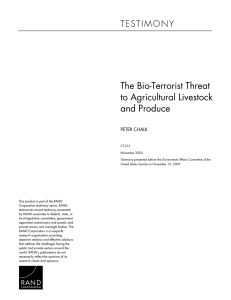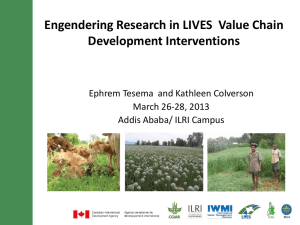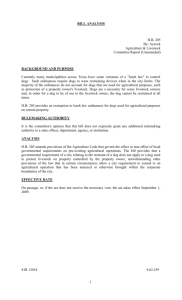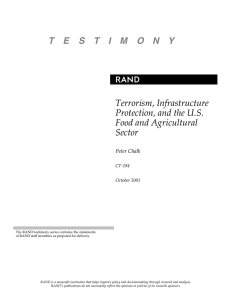The Bio-Terrorist Threat to Agricultural Livestock and Produce
advertisement
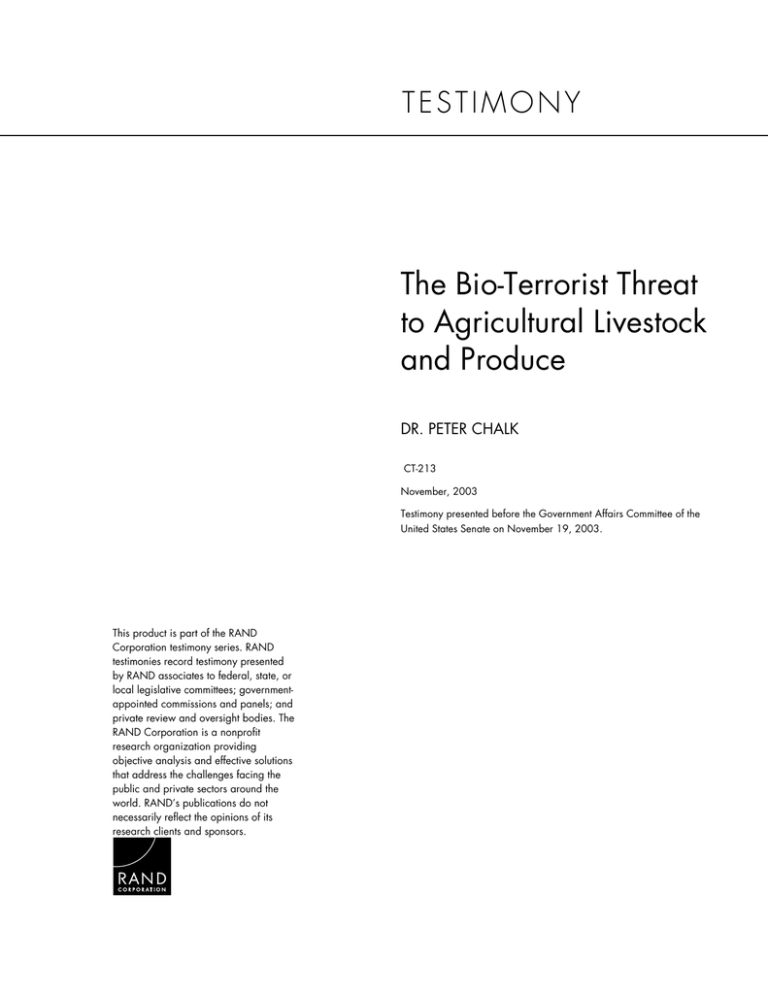
The Bio-Terrorist Threat to Agricultural Livestock and Produce DR. PETER CHALK CT-213 November, 2003 Testimony presented before the Government Affairs Committee of the United States Senate on November 19, 2003. THE BIO-TERRORIST THREAT TO AGRICULTURAL LIVESTOCK AND PRODUCE Statement prepared by Dr Peter Chalk, ∗ Policy Analyst, RAND Santa Monica Office INTRODUCTION Thank you Mr. Chairman and distinguished Members of the Senate Committee on Government Affairs for the opportunity to testify on this important subject. Over the past decade, the United States has moved to increase its ability to detect, prevent and respond to terrorist threats and incidents. Much of this focus, which has involved considerable financial outlays, has aimed at upgrading public infrastructure through the development of vulnerability threat analyses designed to maximize both anti-terrorist contingencies and consequence management modalities. While many gaps remain, investments in preparedness, training and response have helped with the development of at least nascent incident command structures that have incrementally begun to span the ambit of potential terrorist attacks, from conventional bombings to more “exotic” biological, chemical, radiological and nuclear incidents. Agriculture is one area that has received comparatively little attention in this regard, however. In terms of accurate threat assessments and consequence management procedures, the industry exists somewhat as a latecomer to the growing emphasis that has been given to critical infrastructure protection (CIP) in this country. Indeed the sector was only incorporated as a specific component of U.S. national counter-terrorist strategy ∗ This testimony is based on the author’s cumulative knowledge of terrorism and threats to US agriculture. No Federal government grants or monies were used to prepare this written statement. The opinions and conclusions expressed both in this testimony and the background research from which it is derived are entirely the author’s own and should not be interpreted as representing those of RAND of any of the sponsors of its research. *This product is part of the RAND Corporation testimony series. RAND testimonies record testimony presented by RAND associates to federal, state, or local legislative commissions and panels; and private review and oversight bodies. The RAND Corporation is a nonprofit research organization providing objective analysis and effective solutions that address the challenges facing the public and private sectors around the world. RAND’s publications do not necessarily reflect the opinions of its research clients and sponsors. 2 following al-Qaeda’s attacks on the Pentagon and World Trade Center in September 2001.1 This testimony aims to expand the current debate on domestic homeland security by assessing the vulnerabilities of agriculture and the food chain to a deliberate act of biological terrorism. For the purposes of this testimony, agro-terrorism will be defined as the deliberate introduction of a disease agent, either against livestock or into the general food chain, for the purposes of undermining national stability and/or engendering public fear. Depending on the disease agent and vector chosen, it is a tactic that can be used either to generate either economic, social and political disruption or as a form of direct human aggression. THE IMPORTANCE OF THE US AGRICULTURAL AND FOOD SECTOR AND ITS VULNERABILITY TO SABOTAGE Agriculture and the general food industry are highly important to the social, economic and, arguably, political stability of the United States. Although farming directly employs less than three percent of the American population, one in eight people work in an occupation that is directly supported by food production.2 Cattle and dairy farmers alone earn between $50 billion and $54 billion a year through meat and milk sales,3 1 It should be noted that Agriculture and Food Safety is included as one of eight sub-groups of the National Security Council’s (NSC) Weapons of Mass Destruction Preparedness Group, which was established in 1998 under the auspices of Presidential Decision Directive 62 (PDD-62), “Combating Terrorism.” The USDA serves as chair of this sub-group. However, the Department is a relative latecomer to the national security and defense structure and presently lacks sufficient visibility and influence to champion greater Federal attention to countering biological attacks against agriculture (which is, itself, invariably overshadowed by other terrorism-related issues). See Henry Parker Agricultural Bioterrorism: A Federal Strategy to Meet the Threat. McNair Paper 65 (Washington D.C.: Institute for National Strategic Studies, National Defense University, March 2002), 30. 2 Agricultural Research Service, “Econoterrorism, a.k.a. Agricultural Bioterrorism or Asymmetric Use of Bioweapons,” unclassified briefing given before the United States Department of Agriculture (USDA), February 28, 2000. See also Parker, Agricultural Bioterrorism: A Federal Strategy to Meet the Threat, 11. 3 Overall livestock sales in 2001 were in excess of $108 billion. See “Agro-Terrorism Still a Credible Threat,” The Wall Street Journal, December 26 2001. 3 while roughly $50 billion is raised every year through farm-related exports. In 2001, food production constituted 9.7 percent of the U.S. GDP, generating cash receipts in excess of $991 billion.4 Unfortunately, the agricultural and food industries remain vulnerable to deliberate disruption. Critical considerations in this regard include: The Concentrated and Intensive Nature of Contemporary US Farming Practices Agriculture is both a large-scale and intensive business in the United States. Most dairies in the country can be expected to contain at least 1,500 lactating cows at any one time, with some of the largest facilities housing upwards of 10,000 animals.5 Unlike humans, these animals exist as highly concentrated populations and tend to be bred and reared in extreme proximity to one another. The outbreak of a contagious disease at one of these facilities would be very difficult to contain, especially if it was airborne in nature, and could well necessitate the destruction of all exposed livestock – a formidable and highly expensive task. Indicative of this was the recent outbreak of Exotic Newcastle Disease (END) in late 2002, which by October of this year had led to the slaughter of over three million chickens in several counties across California.6 The Increased Disease Susceptibility of Livestock U.S. livestock has become progressively more disease prone in recent years as a result of husbandry changes and biotechnology innovations that have been introduced to increase the quality and quantity of meat production as well as to meet the specific 4 Bureau of Economic Analysis, “Gross Domestic Product: First Quarter 2002 (Advance),” available on-line at http://www.bea.doc.gov/bea/newsrel/gdp102a.htm. 5 See, for instance, Siobhan Gorman, “Bioterror Down on the Farm,” National Journal 27 (July 1999): 812; and Agricultural Research Service (ARS), Agriculture’s Defenses Against Biological Warfare and Other Outbreaks, 2. Currently, roughly three quarters of all dairy commodities are concentrated in the hands of less than ten percent of the country’s cow and calf production facilities. 6 See “Exotic Newcastle Disease Update,” CDFA Animal Health Branch Press Release, October 15, 2003, available on-line at http://www.cdfa.ca.gov/ahfs/ah/Newcastle_info.htm Affected counties included Imperial, Orange, Riverside, Santa Barbara, San Bernardino, San Diego, Ventura and Kern. 4 requirements of individual vendors. These modifications, which have included everything from sterilization programs to dehorning, branding, crowding and hormone injections, have combined to elevate the stress levels of exposed animals. This has both lowered their natural tolerance to contagious pathogenic agents as well as increased the “volume” of bacteria that would normally be shed in the event of an infection.7 Insufficient Farm/Food-Related Security and Surveillance A deliberate act of sabotage is simply not something that the majority of the agricultural community have actively thought about, much less physically prepared to guard against. Farms in the U.S. have therefore tended to evolve, not surprisingly, as relatively open affairs, seldom incorporating concerted means to prevent unauthorized access or intrusion. This is especially true of outlying fields and feedlots but is also often the case with respect to centralized facilities such as milking stands. Food processing and packing plants also tend to lack uniform security and safety preparedness measures, particularly those that have proliferated at the lower and medium end of the production spectrum. Thousands of these facilities exist across the country, exhibiting uneven standards of internal quality control, questionable bio-surveillance and highly transient, unscreened workforces.8 Entry-exit controls are not always adequate (and occasionally do not exist at all) and even basic measures such as padlocking storage rooms may not be practiced. Moreover, many small-scale operations do not keep accurate records of their distribution network, meaning that it may not be possible to trace a tainted food item back to its original source of production.9 7 Comments made by Dr Paul Effler, Hawaii State Epidemiologist, during the “Transnational Security Threats in Asia” Conference, Honolulu, Hawaii, August 8-10, 2000. 8 It should be noted that during 2002, the Bush Administration introduced plans to upgrade the screening of workforces employed at food processing plants and packing facilities. It is not clear, however, how comprehensive these checks will be and to what extent they will apply to the thousands of the thousands of small and medium scale plants that exist throughout the U.S. and which necessarily operate on a system of self-regulation. 9 Author interview, California Department of Health and Human Services (CDHHS), Sacramento, August 2000. 5 Inefficient Passive Disease Reporting System Responsibility for reporting unusual disease occurrences in the U.S. lies with agricultural producers. However in many cases, communication channels between and state emergency management personnel remain underdeveloped, particularly with regards to information frameworks that clearly designate relevant regulatory agencies and primary or secondary personnel that need to be contacted in the event of a serious viral or bacterial outbreak. Equally as important, farmers are often reluctant to quickly report outbreaks of notifiable diseases, fearing that if they do so, they will be forced to carry mass, unrecompensed depopulation measures.10 The current operation of the U.S. animal disease reporting system, in other words, does little to avail early pathogenic warning and identification. This is problematic as rapid, confirmed diagnoses are vital to any effective emergency management system, particularly in the case of highly transmissible viral infections such as FMD. Inappropriate Veterinarian and Diagnostic Training The number of appropriately trained veterinarians capable of recognizing and treating exotic livestock diseases is declining in the U.S. In part, this reflects the smaller numbers of people actually entering veterinarian science – itself a product of the lack of educational support and financial incentive given to the discipline in the country – and the preference choices of those that do – most of who tend to focus on domesticated pets such as dogs and cats rather than large-scale husbandry (as this is where the most money is to be made).11 Just as importantly, it is indicative of college curriculae that, in many cases, 10 It should be noted that the USDA is considering a review of indemnity provisions specifically related to foot and mouth disease, which would authorize payments to cover both disinfection costs as well as the full market value of destroyed animals and related products and materials. For a detailed description of the proposed changes see USDA, Foot and Mouth Disease Payment of Indemnity; Update of Provisions [Docket Number 01-069-1], RIN 0597-AB34, November 2002, available on-line at: http://frwebgate.access.gpo.gov 11 Comments made to author during the “AFBF Commodity Advisory Meeting,” Capital Holiday Inn, Washington D.C., January 2002. 6 reportedly do not emphasize FADs sufficiently, with the focus directed toward diseases that are endemic to the United States itself.12 CAPABILITY REQUIREMENTS FOR CARRYING OUT AN AGRO-TERRORIST ATTACK Although vulnerability does not equate to risk and there are few recorded instances of terrorists actually using disease agents against livestock, a realistic potential for such a contingency exists. Indeed what makes the vulnerabilities inherent in agriculture so worrying is that the capability requirements for exploiting these weaknesses are not significant and certainly less than those that would be needed for a human-directed bioattack. At least four factors account for this. First, there is a large menu of agents to choose from, with fifteen “List A” pathogens identified by the Office International des Epizooties (OIE) as having the potential to severely effect agricultural populations and/or trade.13 Most of these diseases are environmentally hardy – being able to exist for extended periods of time on organic or inorganic matter – and many are not routinely vaccinated against in the United States. Second, many FADs cannot be transmitted to humans, meaning that they can be handled with no risk of latent or accidental infection. There is, thus, no requirement on the part of the perpetrator to have an advanced understanding of animal disease epidemiology and transmission modes nor is there any need for elaborate containment 12 Comments made by USDA officials attending the NRC “National Security Implications of Advances in Biotechnology: Threats to Plants and Animals” Planning Meeting, Washington D.C., August 1999. 13 The OIE specifies List A diseases as those “that have the potential for very serious and rapid spread, irrespective of national borders, that are of serious socio-economic or public health consequence and that are of major importance in the international trade of animals and animal products.” List B diseases are defined as those “that are considered to be of socio-economic and/or public health importance within countries and that are significant in the international trade of animals and animal products.” For further details see OIE classification of diseases, available online at http://www.oie.int/eng/maladies/en.classification.htm 7 procedures, personal protective equipment (PPE) and/or prophylaxis antibiotics in the preparation of the agent.14 Third, if the objective is human deaths, the food chain offers a low-tech, yet conducive mechanism for disseminating toxins and bacteria such as salmonella, e-coli and botulism (none of which require any substantial scientific knowledge to isolate or develop). Developments in the farm-to-table food continuum have greatly increased the number of entry points for these agents, which combined with the lack of security and surveillance at many processing and packing plants, has helped to augment the technical ease of orchestrating a food-borne attack.15 Fourth, animal diseases can be quickly spread to affect large numbers of herds over wide geographic areas. This reflects the intensive and concentrated nature of modern farming practices in the US and the increased susceptibility of livestock to viral and bacterial infections (see above). There is, in other words, no obstacle of weaponization which is frequently cited as one of the most important barriers preventing non-state offensive use of biological agents16 - that needs to be overcome in agricultural terrorism as the animals, themselves, become the primary vector for pathogenic transmission. IMPACT OF A MAJOR ATTACK AGAINST AGRICULTURAL LIVESTOCK AND/OR THE FOOD CHAIN The ramifications of a concerted bio-assault on the U.S. meat and food base would be far-reaching and could extend beyond the immediate agricultural community to affect 14 All of these animal pathogens are currently being considered by the Ad Hoc Group of State Parties to the Biological and Toxin Weapons Convention (BTWC). 15 Comments made by Janet Kause during the “Bioterrorism in the United States: Calibrating the Threat” Seminar, Carnegie Endowment for International Peace, Washington D.C., January 2000. 16 A good summary of the technical constraints inherent in weaponizing biological agents can be found in Seth Carus, Bioterrorism and Biocrimes: The Illicit Use of Biological Agents in the 20th Century (National Defense University, Washington D.C.: Center for Counterproliferation Research, 1999) 26-29. 8 other segments of society. It is possible to envision at least three major effects that might result. Economic Disruption Perhaps one of the most immediate effects of a major act of biological agroterrorism would be economic disruption, generating costs that could be expected to cross at least three levels. First, there would be direct losses resulting from containment measures and the eradication of disease-ridden livestock. Second, indirect multiplier effects would accrue both from compensation paid to farmers for the destruction of agricultural commodities17 and revenue deficits suffered by both directly and indirectly related industries.18 Third, international costs in the form of protective embargoes imposed by major external trading partners would manifest. One study from California, which presented eight different scenarios associated with a theoretical FMD outbreak, concluded each day of delay in instituting effective eradication and control measures would cost the state $1 billion in trade sanctions.19 Loss of Political Support and Confidence 17 Although the U.S. has no standardized system of compensation in place, Federal funds would be forthcoming in the event of a large-scale agricultural disaster such as a multi-focal outbreak of FMD. 18 As the 2001 outbreak of FMD in the United Kingdom illustrates, the extent of these costs can be very high. By the year’s end, well over US$1.6 billion had been paid in compensation to farmers affected by mass culling operations, with losses to tourism as a result of cancellations brought about by the quarantine of farms located in or near popular holiday destinations such as the Lake District estimated to have been in the range of US$4 billion (at an exchange rate of US$1=0.60 pence). See “Farmers Paid GBP1 Bn For Culled Animals,” The Daily Telegraph (UK), June 30, 2001; “After Foot and Mouth,” The Economist, May 5, 2001; “Spring Returns to Rural Britain, But Not Tourists,” The Washington Post, March 16, 2001. 19 Author interview, California Department of Food and Agriculture (CDFA) officials, Sacramento, September 2000. See also “Eastern Oregon Farmers Ready to Eradicate Cattle Disease Threat,” The Oregonian, August 17, 1999. 9 A successful bio-attack against the U.S. agricultural sector could also serve to undermine confidence and support in state governance. Successfully releasing contagious agents against livestock might cause people to lose confidence in the safety of the food supply and could possibly lead them to question the effectiveness of existing contingency planning against weapons of mass destruction in general. The actual mechanics of dealing with an act of agricultural bioterrorism could also generate public criticism. Containing a major disease outbreak would necessitate the slaughter of hundreds of thousands of animals, particularly in cases where no concerted vaccination was in place. Euthanizing such volumes has the potential to generate vigorous opposition from the general population - not to mention farmers and animal rights advocates - particularly if slaughtering involved susceptible but non-disease showing herds (so-called fire breaker operations) and/or wildlife.20 Social Instability Beyond immediate economic and political impacts, bio-terrorist assaults against agriculture have the potential to create public angst and could, possibly, stimulate socially disruptive rural-urban migrations. Several animal diseases are zoonotic in nature, meaning they have the ability to “jump” species and affect humans. Should an epidemic of any one of these diseases occur in the U.S., it could have severe repercussions in terms of galvanizing a mass public scare throughout the country, particularly if human deaths actually occurred. Terrorists could use this to their advantage, allowing them to create a general atmosphere of fear and anxiety without actually having to carry out indiscriminate civilian-oriented attacks (and “accepting” all this entails in terms of attracting mass reprisals and alienating actual or potential support). 20 To be sure, mass eradication has occurred in the past in the US without triggering widespread civil disquiet. However, such operations have not involved large-scale husbandry (for the most part focusing on poultry flocks) nor have they been the subject of intensive media interest and scrutiny. It is these latter aspects that have relevance in terms of assessing the possible fall-out from culling measures, largely because they necessarily mean there has never been a visual point of reference to prepare the American general public for the consequences of eradicating highly visible animal herds. 10 BIOLOGICAL ASSAULTS AGAINST AGRICULTURE AND TERRORISM MODUS OPERANDI Despite the ease by which an act of agro-terrorism could be carried out and the severe ramifications that a successful assault could elicit (especially in terms of economic and political fallout), it is unlikely to constitute a primary form of terrorist aggression. This is because such acts would probably be viewed as “too dry” in comparison with traditional tactics in the sense that they do not produce immediate, visible effects. The impact, while significant, is delayed – lacking a single point of reference for the media to focus on (and highlight).21 In this light, it is perhaps understandable that biological attacks against agriculture have not emerged as more of a problem. Indeed since 1912, there have been a mere twelve documented cases involving the sub-state use of pathogenic agents to infect livestock or contaminate related produce. Of these, only two incidents could in any way be termed terroristic in nature: the 1984 Rajneeshee salmonella food poisoning in Oregon and the 1952 Mau Mau plant toxin incident in Kenya. This being said, agro-terrorism could emerge as favored form of secondary aggression that is designed to exacerbate and entrench the general societal disorientation caused by a more conventional campaign of bombings. The mere ability to employ cheap and unsophisticated means to undermine a state’s economic base and possibly overwhelm its public management resources give livestock and food-related attacks a beneficial cost/benefit payoff that would be of interest to any group faced with significant power asymmetries. Thank you for your time. I will be happy to respond to any questions that you might have. 21 See, for instance, Brian Jenkins, “Future Trends in International Terrorism,” in Robert Slater and Michael Stohl eds., Current Perspectives on International Terrorism (London: Macmillan Press, 1988). 11
